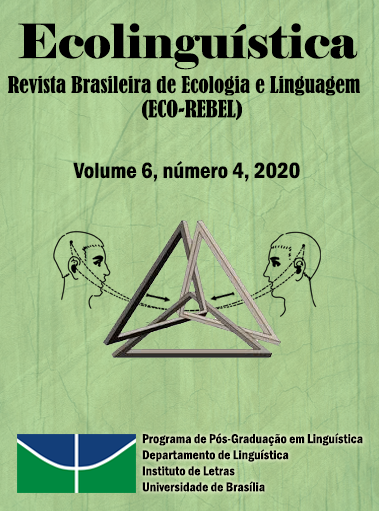Pandemics and nonhuman animals in the argentine press: extended carnism and industrial fatalism
Palavras-chave:
COVID-19; Animais não humanos, Discurso, Ecolinguística.Resumo
O presente trabalho faz parte de uma pesquisa dedicada à construção da identidade discursiva carnista na Argentina. Nosso objetivo neste artigo é analisar como a imprensa argentina constrói animais não humanos durante a pandemia de COVID-19 nas notícias. Analisaremos três notícias diferentes tiradas de dois grandes jornais de Buenos Aires com edições nacionais. Adotaremos como principal referencial teórico Ecolinguística, conforme proposto por STIBBE (2012, 2014). Nessa perspectiva, o discurso da economia neoclássica constrói uma relação destrutiva entre humanos e não humanos através da linguagem. Aplicaremos as ferramentas teóricas fornecidas por HODGE & KRESS (1993) para análise verbal e KRESS & VAN LEEUWEN (2006) e HART (2014) para análise de imagem.
Nossa hipótese de trabalho é que apenas três posições são permitidas a animais não humanos nesses trabalhos: supressão, fundo e presença ornamental (VAN LEEUWEN, 2008), concedendo lugares de subalternidade a animais não humanos (SPIVAK, 1988).
Downloads
Referências
ADAMS, C. The Sexual Politics of Meat. A Feminist-Vegetarian Critical Theory. London: Continuum, 2017.
ANSHELM, J. & HULTMAN, M. Discourses of Global Climate Change: Apocalyptic framing and political antagonisms. New York: Routledge, 2015.
COVID-19 Dashboard by the Center for Systems Science and Engineering (CSSE) at Johns Hopkins University (JHU) (2020). 4 May 2020 Report. Available online: https://gisanddata.maps.arcgis.com/apps/opsdashboard/index.html#/bda7594740fd40299423467b48e9ecf6 (access: 05/04/2020).
DIETZ, T.; YORK, R. (2015). Animals, Capital and Sustainability. Human Ecology Review, 22(1), 35-54. Retrieved December 9, 2020, from http://www.jstor.org/stable/24875147
FORTE, D. La construcción del discurso identitario nacional argentino: la historia de la carne. Question. Vol 1. No. 64. La Plata: Universidad Nacional de La Plata, 2019. ISSN 1669-6581.
HALLIDAY, M.A.K. Language as social semiotic: The social interpretation of language and meaning. London: Edward Arnold, 1978.
HART, C. Discourse, Grammar and Ideology. London: Bloomsbury, 2014.
HODGE, R. & KRESS, G. Language as Ideology. London: Routledge, 1993.
HRIBAL, J. (2007). Animals, Agency, and Class: Writing the History of Animals from Below. Human Ecology Review, Vol. 14, No. 1, 2007, p. 101-112.
HURST, E. (2019). Let’s not be hypocritical about dog meat. PETA Australia. Available online https://prime.peta.org/2019/06/lets-not-be-hypocritical-about-dog-meat/ (access: 05/04/2020).
INSTITUTO CERVANTES. A perro flaco todo son pulgas. Avalilable online : [https://cvc.cervantes.es/lengua/refranero/ficha.aspx?Par=58106&Lng=0] (access: 05/04/2020).
JOY, M. (2011). Why we love dogs, eat pigs and wear cows. An introduction to Carnism. San Francisco: Conari Press, 2011.
KRESS, G. & VAN LEEUWEN, T. Reading Images: a grammar of visual design. London: Routledge, 2006.
LAKOFF, G. (2014). Don’t think of an elephant! Know Your Values and Frame the Debate. Vermont: Chelsea Green Publishing, 2004.
LAKOFF, G. Why it matters how we frame the environment. Environmental Communication v. 4, n. 1, 2010, p. 70-81.
NAVARRO, A. Representaciones e identidades del discurso especista: el caso de la carne vacuna y sus derivados en la Argentina (2000-2012). La Plata, Argentina: Universidad Nacional de La Plata, Facultad de Periodismo y Comunicación Social. Doctoral Dissertation, 2016.
RAITER, A. Lenguaje y sentido común. Buenos Aires: Biblos, 2003.
SILK, C. Front Page Editorials: a Stylist Change for the Future?. Editors' Weblog. World Editors' Forum, 2009. Available online: [http://www.editorsweblog.org/newspaper/2009/06/front-page_editorials_a_stylistic_change.php] (access: 07/01/2011).
SPIVAK, G. C. Can the subaltern speak? Basingstoke: Macmillan, 1988.
STIBBE, A. Animals Erased. Discourse, Ecology, and the reconnection with the natural world. Middletown CT: Wesleyan University Press, 2012.
STIBBE, A. (2014). Ecolinguistics. Language, Ecology and the Stories we live by. London: Routledge, 2014.
VAN LEEUWEN, T. Discourse and Practice. London: Routledge, 2018.
WHORF, B.L. (1956). Language, thought, and reality: selected writings. Cambridge, Mass.: Technology Press of Massachusetts Institute of Technology.
Downloads
Publicado
Como Citar
Edição
Seção
Licença
Copyright (c) 2020 Ecolinguística: Revista brasileira de ecologia e linguagem (ECO-REBEL)

Este trabalho está licenciado sob uma licença Creative Commons Attribution-NonCommercial-NoDerivatives 4.0 International License.
Autores que publicam nesta revista concordam com os seguintes termos:
Autores mantêm os direitos autorais e concedem à revista o direito de primeira publicação, sendo o trabalho simultaneamente licenciado sob a Creative Commons Attribution License o que permite o compartilhamento do trabalho com reconhecimento da autoria do trabalho e publicação inicial nesta revista.
Autores têm autorização para assumir contratos adicionais separadamente, para distribuição não exclusiva da versão do trabalho publicada nesta revista (ex.: publicar em repositório institucional ou como capítulo de livro), com reconhecimento de autoria e publicação inicial nesta revista.
Autores têm permissão e são estimulados a publicar e distribuir seu trabalho online (ex.: em repositórios institucionais ou na sua página pessoal) a qualquer ponto antes ou durante o processo editorial, já que isso pode gerar alterações produtivas, bem como aumentar o impacto e a citação do trabalho publicado (Veja O Efeito do Acesso Livre).



3.png)



